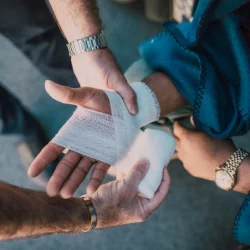Understanding New Mexico's Comparative Fault System: How It Impacts Car Accident Claims
Motor vehicle accidents are an unfortunate fact of life, whether you're driving through Albuquerque's busy streets or across our state’s vast rural landscape. Furthermore, New Mexico, like other states, has its own set of rules and restrictions that impact accident claims and vary depending on the circumstances of your crash.
Of course, proving fault in a New Mexico car accident is essential to receiving financial compensation for injuries and property damage. That said, these claims can quickly get complicated, particularly when there are multiple injured victims or more than one at-fault party.
In fact, the victim filing a claim may even share fault for their accident, reducing the compensation to which they’re entitled. If you have questions about New Mexico’s comparative fault system or how to handle your potential accident claim, read on to learn more and contact an Albuquerque car accident attorney as soon as possible.
How is Fault Determined in New Mexico?
Two primary models for handling liability after a car accident are fault and no-fault. The majority of states operate under a "fault" system. In other words, the at-fault, negligent motorist (or their insurance company) must compensate the victim for their damages.
While state laws regarding negligence may differ, there are typically four elements that must be shown to establish fault after a car accident in New Mexico and beyond:
- Another motorist had an obligation or “duty of care” to drive safely or act in a reasonable manner behind the wheel.
- The at-fault driver neglected this obligation or violated their duty of care.
- The other driver’s negligence caused the accident.
- The injuries and other damages in the claim were directly caused by the accident in question.
You can prove your case to the insurance company or a judge by providing documents such as witness testimonies, police reports, pictures of the accident scene, medical records, and any other expenses or written details describing a crash.
How Fault Impacts Accident Claims in New Mexico
The question of who is at fault in a vehicle crash is rarely straightforward. As mentioned above, it’s possible that the actions of multiple parties played a role in causing an auto accident.
Also, regardless of the details surrounding a car wreck, insurance companies frequently try to suggest, due to the comparative negligence system in New Mexico, that the injured contributed to an accident, even when they truly are not at fault at all. Doing so successfully would mean they have to pay less out on a claim if they can transfer some of the blame to the plaintiff.
What is Comparative Negligence?
In cases where fault for an accident can be reasonably assigned to more than one party, the court will divide any resulting damages amongst the parties in proportion to their respective degrees of fault.
To preserve a company’s bottom line, insurers often try anything and everything they can to minimize a claim’s value or avoid paying out a claim altogether. Insurance adjusters may try to argue comparative or contributory negligence.
For instance, consider a situation in which one driver weaves in and out of traffic lanes without checking for other vehicles and is hit by another driver who’s speeding. Each of the drivers would be responsible for the crash because they each broke the law and contributed to the accident that occurred.
So, if one of the motorists makes a claim for personal injury and the court rules that the plaintiff's conduct means they’re 40% at fault for the accident, the plaintiff's award will be reduced by 40%.
Some comparative negligence states don’t allow a person to file a claim if their level of fault exceeds 50%. But because of New Mexico’s doctrine of pure comparative negligence, a driver can make a claim for compensation as long as they’re not 100% at fault.
Pure Comparative Fault and Damages in New Mexico
Contributory fault, pure comparative fault, and modified comparative fault are the three main approaches used to determine negligence in civil cases and award damages accordingly. Once again, because New Mexico injury law follows pure comparative fault, multiple parties can file a claim for an accident, even if some of the drivers were more at fault than the others involved.
Damages, in the context of a car accident claim, are the monetary compensation granted to the plaintiff(s). These damages or losses are determined by an insurance claim, private settlement negotiation, or a court trial. The most prevalent forms of compensation, both economic and non-economic, in New Mexico car accident cases are as follows:
- Personal property damage, such as damage to your vehicle requiring repairs
- Accident-related medical costs, including both those sustained before and after a crash
- Losses of income and earning potential, which comprise the total of present and future wages a victim has lost as a result of a crash
- Non-economic damages, such as those for pain and suffering
Another form, known as punitive damages, is assessed where the other driver's actions can be shown to have been motivated by malice or reckless disregard for the safety of others. Punitive damages are less common in car accident cases.
There is no cap on economic or non-economic damages in New Mexico, and unlike in several other states, there is also no limit on punitive damages. Only in circumstances involving claims against the government and certain types of medical malpractice are damages limited by New Mexico law.
The Role of an Attorney in New Mexico Car Accident Claims
Although filing an insurance claim or a personal injury case following a car accident does not require by law the services of a personal injury or car accident attorney in New Mexico, victims are best served by qualified legal representation in the aftermath of a crash.
When you've suffered serious injuries or another driver’s insurer uses contributory or comparative negligence as a defense against your claim, an attorney can help you negotiate with the insurance companies to ensure you receive the maximum possible settlement amount to cover your losses.
More to Read:
Previous Posts:




